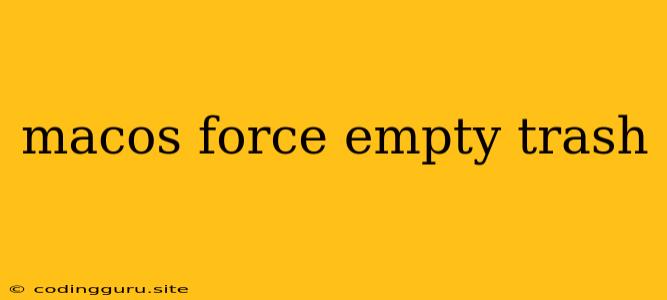macOS Force Empty Trash: A Comprehensive Guide
Have you ever encountered the frustrating situation where you emptied your Trash on macOS, but it still seemed full? You might be facing an issue with files being locked, or perhaps there's a stubborn file refusing to budge. Fortunately, there are effective solutions to force empty trash on your Mac. Let's explore the common scenarios and the best ways to resolve them.
Why Can't I Empty My Trash?
There are several reasons why you might not be able to empty your Trash on macOS:
- Locked Files: If a file is open or being used by a program, you won't be able to delete it.
- System Files: macOS protects system files from being deleted without specific permission.
- Disk Permission Issues: In some cases, your account might not have the necessary permissions to delete files in certain locations.
- Corrupted Files: Occasionally, a file could become corrupted, preventing it from being deleted.
- External Drive Issues: If your Trash contains files from an external drive that is not properly mounted, you might not be able to empty it.
How to Force Empty Trash on macOS
Here are several methods to force empty your Trash on macOS:
1. The Standard Approach (Try This First)
- Open Finder: Locate the Finder icon in your Dock.
- Go to Trash: Click on the "Trash" icon in the Finder sidebar.
- Empty Trash: Press the "Empty Trash" button at the top of the window.
- Confirm: If prompted, confirm that you want to permanently delete the files.
2. Force Empty Trash Using Terminal
If the standard approach doesn't work, you can use the Terminal to forcefully delete files in your Trash. This method requires caution as it permanently removes files without warning.
- Open Terminal: Open the Terminal application from your Applications folder.
- Type the Command: Type the following command and press Enter:
sudo rm -rf ~/.Trash/* - Enter your password: You'll be prompted for your administrator password. Type it in and press Enter.
- Confirm Deletion: The Terminal will confirm the deletion of files in your Trash.
3. Troubleshooting Specific File Issues
If you know the name of the file preventing you from emptying your Trash, you can try the following:
- Open Activity Monitor: Locate the Activity Monitor app in your Applications folder.
- Find the Process: Look for the process associated with the locked file (e.g., a specific program name).
- Force Quit: Select the process and click the "Force Quit" button in the Activity Monitor window.
- Empty Trash Again: Try emptying your Trash again after the process is terminated.
4. Using Disk Utility
In some cases, you might need to repair disk permissions or run a disk scan using Disk Utility:
- Open Disk Utility: Locate the Disk Utility app in your Applications folder.
- Select Your Hard Drive: Choose your primary hard drive (usually named "Macintosh HD") in the sidebar.
- Run First Aid: Click the "First Aid" button to scan and repair any disk errors.
- Re-Empty Trash: After the repair process, try emptying your Trash again.
Tips to Avoid Future Issues with Your Trash
- Regularly Empty Your Trash: Empting your Trash frequently can prevent files from accumulating and causing potential issues.
- Check for Open Files: Before emptying your Trash, ensure no programs are accessing files that you want to delete.
- Avoid Moving System Files: Do not move or delete important system files unless you are an advanced user who fully understands the potential consequences.
- Backup Your Mac: Regularly back up your Mac to protect your data in case of accidental deletion or other problems.
Conclusion
By following these steps, you can successfully force empty your Trash on macOS and clear out any stubborn files. Remember to use caution when using the Terminal or Disk Utility, and always back up your data before performing any significant file operations.
